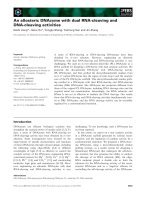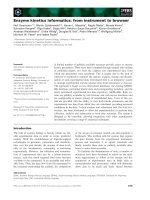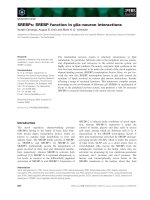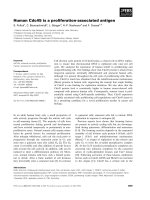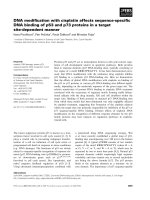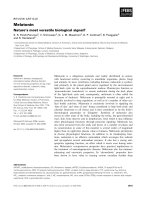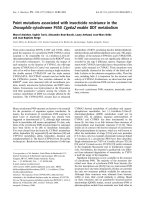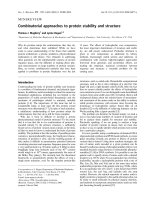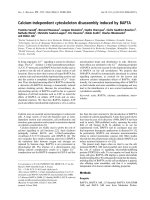Tài liệu Báo cáo khoa học: "Resume Information Extraction with Cascaded Hybrid Model" pdf
Bạn đang xem bản rút gọn của tài liệu. Xem và tải ngay bản đầy đủ của tài liệu tại đây (276.01 KB, 8 trang )
Proceedings of the 43rd Annual Meeting of the ACL, pages 499–506,
Ann Arbor, June 2005.
c
2005 Association for Computational Linguistics
Resume Information Extraction with Cascaded Hybrid Model
Kun Yu Gang Guan Ming Zhou
Department of Computer Science
and Technology
Department of Electronic
Engineering
Microsoft Research Asia
University of Science and
Technology of China
Tsinghua University
5F Sigma Center, No.49 Zhichun
Road, Haidian
Hefei, Anhui, China, 230027 Bejing, China, 100084 Bejing, China, 100080
Abstract
This paper presents an effective approach
for resume information extraction to
support automatic resume management
and routing. A cascaded information
extraction (IE) framework is designed. In
the first pass, a resume is segmented into
a consecutive blocks attached with labels
indicating the information types. Then in
the second pass, the detailed information,
such as Name and Address, are identified
in certain blocks (e.g. blocks labelled
with Personal Information), instead of
searching globally in the entire resume.
The most appropriate model is selected
through experiments for each IE task in
different passes. The experimental results
show that this cascaded hybrid model
achieves better F-score than flat models
that do not apply the hierarchical
structure of resumes. It also shows that
applying different IE models in different
passes according to the contextual
structure is effective.
1 Introduction
Big enterprises and head-hunters receive
hundreds of resumes from job applicants every day.
Automatically extracting structured information
from resumes of different styles and formats is
needed to support the automatic construction of
database, searching and resume routing.
The
definition of resume information fields varies in
different applications. Normally, resume
information is described as a hierarchical structure
The research was carried out in Microsoft Research Asia.
with two layers. The first layer is composed of
consecutive general information blocks such as
Personal Information, Education etc. Then within
each general information block, detailed
information pieces can be found, e.g., in Personal
Information block, detailed information such as
Name, Address, Email etc. can be further extracted.
Info Hierarchy Info Type (Label)
General Info
Personal Information(G
1
);
Education(G
2
); Research
Experience(G
3
); Award(G
4
);
Activity(G
5
); Interests(G
6
);
Skill(G
7
)
Personal
Detailed Info
(Personal
Information)
Name(P
1
); Gender(P
2
);
Birthday(P
3
); Address(P
4
); Zip
code(P
5
); Phone(P
6
);
Mobile(P
7
); Email(P
8
);
Registered Residence(P
9
);
Marriage(P
10
); Residence(P
11
);
Graduation School(P
12
);
Degree(P
13
); Major(P
14
)
Detailed
Info
Educational
Detailed Info
(Education)
Graduation School(D
1
);
Degree(D
2
); Major(D
3
);
Department(D
4
)
Table 1. Predefined information types.
Based on the requirements of an ongoing
recruitment management system which
incorporates database construction with IE
technologies and resume recommendation
(routing), as shown in Table 1, 7 general
information fields are defined. Then, for Personal
Information, 14 detailed information fields are
designed; for Education, 4 detailed information
fields are designed. The IE task, as exemplified in
Figure 1, includes segmenting a resume into
consecutive blocks labelled with general
information types, and further extracting the
detailed information such as Name and Address
from certain blocks.
Extracting information from resumes with high
precision and recall is not an easy task. In spite of
499
Figure 1. Example of a resume and the extracted information.
constituting a restricted domain, resumes can be
written in multitude of formats (e.g. structured
tables or plain texts), in different languages (e.g.
Chinese and English) and in different file types
(e.g. Text, PDF, Word etc.). Moreover, writing
styles could be very diversified.
Among the methods in IE, Hidden Markov
modelling has been widely used (Freitag and
McCallum, 1999; Borkar et al., 2001). As a state-
based model, HMMs are good at extracting
information fields that hold a strong order of
sequence. Classification is another popular method
in IE. By assuming the independence of
information types, it is feasible to classify
segmented units as either information types to be
extracted (Kushmerick et al., 2001; Peshkin and
Pfeffer, 2003; Sitter and Daelemans, 2003), or
information boundaries (Finn and Kushmerick,
2004). This method specializes in settling the
extraction problem of independent information
types.
Resume shares a document-level hierarchical
contextual structure where the related information
units usually occur in the same textual block, and
text blocks of different information categories
usually occur in a relatively fixed order. Such
characteristics have been successfully used in the
categorization of multi-page documents by
Frasconi et al. (2001).
In this paper, given the hierarchy of resume
information, a cascaded two-pass IE framework is
designed. In the first pass, the general information
is extracted by segmenting the entire resume into
consecutive blocks and each block is annotated
with a label indicating its category. In the second
pass, detailed information pieces are further
extracted within the boundary of certain blocks.
Moreover, for different types of information, the
most appropriate extraction method is selected
through experiments. For the first pass, since there
exists a strong sequence among blocks, a HMM
model is applied to segment a resume and each
block is labelled with a category of general
information. We also apply HMM for the
educational detailed information extraction for the
same reason. In addition, classification based
method is selected for the personal detailed
information extraction where information items
appear relatively independently.
Tested with 1,200 Chinese resumes,
experimental results show that exploring the
hierarchical structure of resumes with this
proposed cascaded framework improves the
average F-score of detailed information extraction
500
greatly, and combining different IE models in
different layer properly is effective to achieve
good precision and recall.
The remaining part of this paper is structured as
follows. Section 2 introduces the related work.
Section 3 presents the structure of the cascaded
hybrid IE model and introduces the HMM model
and SVM model in detail. Experimental results
and analysis are shown in Section 4. Section 5
provides a discussion of our cascaded hybrid
model. Section 6 is the conclusion and future work.
2 Related Work
As far as we know, there are few published
works on resume IE except some products, for
which there is no way to determine the technical
details. One of the published results on resume IE
was shown in Ciravegna and Lavelli (2004). In
this work, they applied (LP)
2
, a toolkit of IE, to
learn information extraction rules for resumes
written in English. The information defined in
their task includes a flat structure of Name, Street,
City, Province, Email, Telephone, Fax and Zip
code. This flat setting is not only different from
our hierarchical structure but also different from
our detailed information pieces.
Besides, there are some applications that are
analogous to resume IE, such as seminar
announcement IE (Freitag and McCallum, 1999),
job posting IE (Sitter and Daelemans, 2003; Finn
and Kushmerick, 2004) and address segmentation
(Borkar et al., 2001; Kushmerick et al., 2001).
Most of the approaches employed in these
applications view a text as flat and extract
information from all the texts directly (Freitag and
McCallum, 1999; Kushmerick et al., 2001;
Peshkin and Pfeffer, 2003; Finn and Kushmerick,
2004). Only a few approaches extract information
hierarchically like our model. Sitter and
Daelemans (2003) present a double classification
approach to perform IE by extracting words from
pre-extracted sentences. Borkar et al. (2001)
develop a nested model, where the outer HMM
captures the sequencing relationship among
elements and the inner HMMs learn the finer
structure within each element. But these
approaches employ the same IE methods for all
the information types. Compared with them, our
model applies different methods in different sub-
tasks to fit the special contextual structure of
information in each sub-task well.
3 Cascaded Hybrid Model
Figure 2 is the structure of our cascaded hybrid
model. The first pass (on the left hand side)
segments a resume into consecutive blocks with a
HMM model. Then based on the result, the second
pass (on the right hand side) uses HMM to extract
the educational detailed information and SVM to
extract the personal detailed information,
respectively. The block selection module is used to
decide the range of detailed information extraction
in the second pass.
Figure 2. Structure of cascaded hybrid model.
3.1 HMM Model
3.1.1 Model Design
For general information, the IE task is viewed as
labelling the segmented units with predefined class
labels. Given an input resume T which is a
sequence of words w
1
,w
2
,…,w
k
, the result of
general information extraction is a sequence of
blocks in which some words are grouped into a
certain block T = t
1
, t
2
,…, t
n
, where t
i
is a block.
Assuming the expected label sequence of T is L=l
1
,
l
2
,…, l
n
, with each block being assigned a label l
i
,
we get the sequence of block and label pairs Q=(t
1
,
l
1
), (t
2
, l
2
),…,(t
n
, l
n
). In our research, we simply
assume that the segmentation is based on the
natural paragraph of T.
Table 1 gives the list of information types to be
extracted, where general information is
represented as G
1
~G
7
. For each kind of general
information, say G
i
, two labels are set: G
i
-B means
the beginning of G
i
, G
i
-M means the remainder
part of G
i
. In addition, label O is defined to
represent a block that does not belong to any
general information types. With these positional
information labels, general information can be
obtained. For instance, if the label sequence Q for
501
a resume with 10 paragraphs is Q=(t
1
, G
1
-B), (t
2
,
G
1
-M) , (t
3
, G
2
-B) , (t
4
, G
2
-M) , (t
5
, G
2
-M) , (t
6
, O) ,
(t
7
, O) , (t
8
, G
3
-B) , (t
9
, G
3
-M) , (t
10
, G
3
-M), three
types of general information can be extracted as
follows: G
1
:[t
1,
t
2
], G
2
:[t
3,
t
4
, t
5
], G
3
:[t
8,
t
9
, t
10
].
Formally, given a resume T=t
1
,t
2
,…,t
n
, seek a
label sequence L
*
=l
1
,l
2
,…,l
n
, such that the
probability of the sequence of labels is maximal.
)|(maxarg
*
TLPL
L
=
(1)
According to Bayes’ equation, we have
)()|(maxarg
*
LPLTPL
L
×=
(2)
If we assume the independent occurrence of
blocks labelled as the same information types, we
have
∏
=
=
n
i
ii
ltPLTP
1
)|()|(
(3)
We assume the independence of words
occurring in t
i
and use a unigram model, which
multiplies the probabilities of these words to get
the probability of t
i
.
}, ,{ where), |()|(
21
1
mii
m
r
rii
wwwtlwPltP ==
∏
=
(4)
If a tri-gram model is used to estimate P(L), we
have
∏
=
−−
×=
n
i
iii
lllPllPlPLP
3
21121
),|()|()()(
(5)
To extract educational detailed information
from Education general information, we use
another HMM. It also uses two labels D
i
-B and D
i
-
M to represent the beginning and remaining part of
D
i
, respectively. In addition, we use label O to
represent that the corresponding word does not
belong to any kind of educational detailed
information. But this model expresses a text T as
word sequence T=w
1
,w
2
,…,w
n
. Thus in this model,
the probability P(L) is calculated with Formula 5
and the probability P(T|L) is calculated by
∏
=
=
n
i
ii
lwPLTP
1
)|()|(
(6)
Here we assume the independent occurrence of
words labelled as the same information types.
3.1.2 Parameter Estimation
Both words and named entities are used as
features in our HMMs. A Chinese resume C=
c
1
’,c
2
’,…,c
k
’ is first tokenized into C= w
1
,w
2
,…,w
k
with a Chinese word segmentation system LSP
(Gao et al., 2003). This system outputs predefined
features, including words and named entities in 8
types (Name, Date, Location, Organization, Phone,
Number, Period, and Email). The named entities
of the same type are normalized into single ID in
feature set.
In both HMMs, fully connected structure with
one state representing one information label is
applied due to its convenience. To estimate the
probabilities introduced in 3.1.1, maximum
likelihood estimation is used, which are
),(
),,(
),|(
21
21
21
−−
−−
−−
=
ii
iii
iii
llcount
lllcount
lllP
(7)
)(
),(
)|(
1
1
1
−
−
−
=
i
ii
ii
lcount
llcount
llP
(8)
ordsdistinct w
m
containsistatewhere
,
),(
),(
)|(
1
∑
=
=
m
r
ir
ir
ir
lwcount
lwcount
lwP
(9)
3.1.3 Smoothing
Short of training data to estimate probability is a
big problem for HMMs. Such problems may occur
when estimating either P(T|L) with unknown word
w
i
or P(L) with unknown events.
Bikel et al. (1999) mapped all unknown words
to one token _UNK_ and then used a held-out data
to train the bi-gram models where unknown words
occur. They also applied a back-off strategy to
solve the data sparseness problem when estimating
the context model with unknown events, which
interpolates the estimation from training corpus
and the estimation from the back-off model with
calculated parameter λ (Bikel et al., 1999). Freitag
and McCallum (1999) used shrinkage to estimate
the emission probability of unknown words, which
combines the estimates from data-sparse states of
the complex model and the estimates in related
data-rich states of the simpler models with a
weighted average.
In our HMMs, we first apply Good Turing
smoothing (Gale, 1995) to estimate the probability
P(w
r
|l
i
) when training data is sparse. For word w
r
seen in training data, the emission probability is
P(w
r
|l
i
)×(1-x), where P(w
r
|l
i
) is the emission
probability calculated with Formula 9 and x=E
i
/S
i
(E
i
is the number of words appearing only once in
state i and S
i
is the total number of words
occurring in state i). For unknown word w
r
, the
emission probability is x/(M-m
i
), where M is the
number of all the words appearing in training data,
502
and m
i
is the number of distinct words occurring in
state i. Then, we use a back-off schema (Katz,
1987) to deal with the data sparseness problem
when estimating the probability P(L) (Gao et al.,
2003).
3.2 SVM Model
3.2.1 Model Design
We convert personal detailed information
extraction into a classification problem. Here we
select SVM as the classification model because of
its robustness to over-fitting and high performance
(Sebastiani, 2002). In the SVM model, the IE task
is also defined as labelling segmented units with
predefined class labels. We still use two labels to
represent personal detailed information P
i
: P
i
-B
represents the beginning of P
i
and P
i
-M represents
the remainder part of P
i
. Besides of that, label O
means that the corresponding unit does not belong
to any personal detailed information boundaries
and information types. For example, for part of a
resume “Name:Alice (Female)”, we got three units
after segmentation with punctuations, i.e. “Name”,
“Alice”, “Female”. After applying SVM
classification, we can get the label sequence as P
1
-
B,P
1
-M,P
2
-B. With this sequence of unit and label
pairs, two types of personal detailed information
can be extracted as P
1
: [Name:Alice] and P
2
:
[Female].
Various ways can be applied to segment T. In
our work, segmentation is based on the natural
sentence of T. This is based on the empirical
observation that detailed information is usually
separated by punctuations (e.g. comma, Tab tag or
Enter tag).
The extraction of personal detailed information
can be formally expressed as follows: given a text
T=t
1
,t
2
,…,t
n
, where t
i
is a unit defined by the
segmenting method mentioned above, seek a label
sequence L* = l
1
,l
2
,…,l
n
, such that the probability
of the sequence of labels is maximal.
)|(maxarg
*
TLPL
L
=
(10)
The key assumption to apply classification in IE
is the independence of label assignment between
units. With this assumption, Formula 10 can be
described as
∏
=
=
=
n
i
ii
lllL
tlPL
n
1
,
*
)|(maxarg
21
(11)
Thus this probability can be maximized by
maximizing each term in turn. Here, we use the
SVM score of labelling t
i
with l
i
to replace P(l
i
|t
i
).
3.2.2 Multi-class Classification
SVM is a binary classification model. But in our
IE task, it needs to classify units into N classes,
where N is two times of the number of personal
detailed information types. There are two popular
strategies to extend a binary classification task to
N classes (A.Berger, 1999). The first is One vs. All
strategy, where N classifiers are built to separate
one class from others. The other is Pairwise
strategy, where N×(N-1)/2 classifiers considering
all pairs of classes are built and final decision is
given by their weighted voting. In our model, we
apply the One vs. All strategy for its good
efficiency in classification. We construct one
classifier for each type, and classify each unit with
all these classifiers. Then we select the type that
has the highest score in classification. If the
selected score is higher than a predefined threshold,
then the unit is labelled as this type. Otherwise it is
labelled as O.
3.2.3 Feature Definition
Features defined in our SVM model are
described as follows:
Word: Words that occur in the unit. Each word
appearing in the dictionary is a feature. We use
TF×IDF as feature weight, where TF means word
frequency in the text, and IDF is defined as:
w
N
N
LogwIDF
2
)( =
(12)
N: the total number of training examples;
N
w
: the total number of positive examples that contain word w
Named Entity: Similar to the HMM models, 8
types of named entities identified by LSP, i.e.,
Name, Date, Location, Organization, Phone,
Number, Period, Email, are selected as binary
features. If any one type of them appears in the
text, then the weight of this feature is 1, otherwise
is 0.
3.3 Block Selection
Block selection is used to select the blocks
generated from the first pass as the input of the
second pass for detailed information extraction.
Error analysis of preliminary experiments shows
that the majority of the mistakes of general
information extraction resulted from labelling non-
503
Personal Detailed Info (SVM) Educational Detailed Info (HMM)
Model
Avg.P (%) Avg.R (%) Avg.F (%) Avg.P (%) Avg.R (%) Avg.F (%)
Flat 77.49 82.02 77.74 58.83 77.35 66.02
Cascaded 86.83 (+9.34) 76.89 (-5.13) 80.44 (+2.70) 70.78 (+11.95) 76.80 (-0.55) 73.40 (+7.38)
Table 2. IE results with cascaded model and flat model.
boundary blocks as boundaries in the first pass.
Therefore we apply a fuzzy block selection
strategy, which not only selects the blocks labelled
with target general information, but also selects
their neighboring two blocks, so as to enlarge the
extracting range.
4 Experiments and Analysis
4.1 Data and Experimental Setting
We evaluated this cascaded hybrid model with
1,200 Chinese resumes. The data set was divided
into 3 parts: training data, parameter tuning data
and testing data with the proportion of 4:1:1. 6-
folder cross validation was conducted in all the
experiments. We selected SVMlight (Joachims,
1999) as the SVM classifier toolkit and LSP (Gao
et al., 2003) for Chinese word segmentation and
named entity identification. Precision (P), recall (R)
and F-score (F=2PR/(P+R)) were used as the basic
evaluation metrics and macro-averaging strategy
was used to calculate the average results. For the
special application background of our resume IE
model, the “Overlap” criterion (Lavelli et al., 2004)
was used to match reference instances and
extracted instances. We define that if the
proportion of the overlapping part of extracted
instance and reference instance is over 90%, then
they match each other.
A set of experiments have been designed to
verify the effectiveness of exploring document-
level hierarchical structure of resume and choose
the best IE models (HMM vs. classification) for
each sub-task.
z Cascaded model vs. flat model
Two flat models with different IE methods
(SVM and HMM) are designed to extract personal
detailed information and educational detailed
information respectively. In these models, no
hierarchical structure is used and the detailed
information is extracted from the entire resume
texts rather than from specific blocks. These two
flat models will be compared with our proposed
cascaded model.
z Model selection for different IE tasks
Both SVM and HMM are tested for all the IE
tasks in first pass and in second pass.
4.2 Cascaded Model vs. Flat Model
We tested the flat model and cascaded model
with detailed information extraction to verify the
effectiveness of exploring document-level
hierarchical structure. Results (see Table 2) show
that with the cascaded model, the precision is
greatly improved compared with the flat model
with identical IE method, especially for
educational detailed information. Although there is
some loss in recall, the average F-score is still
largely improved in the cascaded model.
4.3 Model Selection for Different IE Tasks
Then we tested different models for the general
information and detailed information to choose the
most appropriate IE model for each sub-task.
Model Avg.P (%) Avg.R (%)
SVM 80.95 72.87
HMM 75.95 75.89
Table 3. General information extraction with
different models.
Personal Detailed
Info
Educational
Detailed Info
Model
Avg.P
(%)
Avg.R
(%)
Avg.P
(%)
Avg.R
(%)
SVM 86.83 76.89 67.36 66.21
HMM 79.64 60.16 70.78 76.80
Table 4. Detailed information extraction with
different models.
Results (see Table 3) show that compared with
SVM, HMM achieves better recall. In our
cascaded framework, the extraction range of
detailed information is influenced by the result of
general information extraction. Thus better recall
of general information leads to better recall of
detailed information subsequently. For this reason,
504
we choose HMM in the first pass of our cascaded
hybrid model.
Then in the second pass, different IE models are
tested in order to select the most appropriate one
for different sub-tasks. Results (see Table 4) show
that HMM performs much better in both precision
and recall than SVM for educational detailed
information extraction. We think that this is
reasonable because HMM takes into account the
sequence constraints among educational detailed
information types. Therefore HMM model is
selected to extract educational detailed information
in our cascaded hybrid model. While for the
personal detailed information extraction, we find
that the SVM model gets better precision and
recall than HMM model. We think that this is
because of the independent occurrence of personal
detailed information. Therefore, we select SVM to
extract personal detailed information in our
cascaded model.
5 Discussion
Our cascaded framework is a “pipeline”
approach and it may suffer from error propagation.
For instance, the error in the first pass may be
transferred to the second pass when determining
the extraction range of detailed information.
Therefore the precision and recall of detailed
information extraction in the second pass may be
decreased subsequently. But we are not sure
whether N-Best approach (Zhai et al., 2004) would
be helpful. Because our cascaded hybrid model
applies different IE methods for different sub-tasks,
it is difficult to incorporate the N-best strategy by
either simply combining the scores of the first pass
and the second pass, or using the scores of the
second pass to do re-ranking to select the best
results. Instead of using N-best, we apply a fuzzy
block selection strategy to enlarge the search scope.
Experimental results of personal detailed
information extraction show that compared with
the exact block selection strategy, this fuzzy
strategy improves the average recall of personal
detailed information from 68.48% to 71.34% and
reduce the average precision from 83.27% to
81.71%. Therefore the average F-score is
improved by the fuzzy strategy from 75.15% to
76.17%.
Features are crucial to our SVM model. For
some fields (such as Name, Address and
Graduation School), only using words as features
may result in low accuracy in IE. The named
entity (NE) features used in our model enhance the
accuracy of detailed information extraction. As
exemplified by the results (see Table 5) on
personal detailed information extraction, after
adding named entity features, the F-score are
improved greatly.
Field Word +NE (%) Word (%)
Name 90.22 3.11
Birthday 87.31 84.82
Address 67.76 49.16
Phone 81.57 75.31
Mobile 70.64 58.01
Email 88.76 85.96
Registered Residence 75.97 72.73
Residence 51.61 42.86
Graduation School 40.96 15.38
Degree 73.20 63.16
Major 63.09 43.24
Table 5. Personal detailed information extraction
with different features (Avg.F).
In our cascaded hybrid model, we apply HMM
and SVM in different pass separately to explore
the contextual structure of information types. It
guarantees the simplicity of our hybrid model.
However, there are other ways to combine state-
based and discriminative ideas. For example, Peng
and McCallum (2004) applied Conditional
Random Fields to extract information, which
draws together the advantages of both HMM and
SVM. This approach could be considered in our
future experiments.
Some personal detailed information types do not
achieve good average F-score in our model, such
as Zip code (74.50%) and Mobile (73.90%). Error
analysis shows that it is because these fields do not
contain distinguishing words and named entities.
For example, it is difficult to extract Mobile from
the text “Phone: 010-62617711 (13859750123)”.
But these fields can be easily distinguished with
their internal characteristics. For example, Mobile
often consists of certain length of digital figures.
To identify these fields, the Finite-State
Automaton (FSA) that employs hand-crafted
grammars is very effective (Hsu and Chang, 1999).
Alternatively, rules learned from annotated data
are also very promising in handling this case
(Ciravegna and Lavelli, 2004).
We assume the independence of words
occurring in unit t
i
to calculate the probability
505
P(t
i
|l
i
) in HMM model. While in Bikel et al. (1999),
a bi-gram model is applied where each word is
conditioned on its immediate predecessor when
generating words inside the current name-class.
We will compare this method with our current
method in the future.
6 Conclusions and Future Work
We have shown that a cascaded hybrid model
yields good results for the task of information
extraction from resumes. We tested different
models for the first pass and the second pass, and
for different IE tasks. Our experimental results
show that the HMM model is effective in handling
the general information extraction and educational
detailed information extraction, where there exists
strong sequence of information pieces. And the
SVM model is effective for the personal detailed
information extraction.
We hope to continue this work in the future by
investigating the use of other well researched IE
methods. As our future works, we will apply FSA
or learned rules to improve the precision and recall
of some personal detailed information (such as Zip
code and Mobile). Other smoothing methods such
as (Bikel et al. 1999) will be tested in order to
better overcome the data sparseness problem.
7 Acknowledgements
The authors wish to thank Dr. JianFeng Gao, Dr.
Mu Li, Dr. Yajuan Lv for their help with the LSP
tool, and Dr. Hang Li, Yunbo Cao for their
valuable discussions on classification approaches.
We are indebted to Dr. John Chen for his
assistance to polish the English. We want also
thank Long Jiang for his assistance to annotate the
training and testing data. We also thank the three
anonymous reviewers for their valuable comments.
References
A.Berger. Error-correcting output coding for text
classification. 1999. In Proceedings of the IJCAI-99
Workshop on Machine Learning for Information Filtering.
D.M.Bikel, R.Schwartz, R.M.Weischedel. 1999. An algorithm
that learns what’s in a name. Machine Learning,
34(1):211-231.
V.Borkar, K.Deshmukh and S.Sarawagi. 2001. Automatic
segmentation of text into structured records. In
Proceedings of ACM SIGMOD Conference. pp.175-186.
F.Ciravegna, A.Lavelli. 2004. LearningPinocchio: adaptive
information extraction for real world applications. Journal
of Natural Language Engineering, 10(2):145-165.
A.Finn and N.Kushmerick. 2004. Multi-level boundary
classification for information extraction. In Proceedings of
ECML04.
P.Frasconi, G.Soda and A.Vullo. 2001. Text categorization
for multi-page documents: a hybrid Naïve Bayes HMM
approach. In Proceedings of the 1st ACM/IEEE-CS Joint
Conference on Digital Libraries. pp.11-20.
D.Freitag and A.McCallum. 1999. Information extraction
with HMMs and shrinkage. In AAAI99 Workshop on
Machine Learning for Information Extraction. pp.31-36.
W.Gale. 1995. Good-Turing smoothing without tears. Journal
of Quantitative Linguistics, 2:217-237.
J.F.Gao, M.Li and C.N.Huang. 2003. Improved source-
channel models for Chinese word segmentation. In
Proceedings of ACL03. pp.272-279.
C.N.Hsu and C.C.Chang. 1999. Finite-state transducers for
semi-structured text mining. In Proceedings of IJCAI99
Workshop on Text Mining: Foundations, Techniques and
Applications. pp.38-49.
T.Joachims. 1999. Making large-scale SVM learning practical.
Advances in Kernel Methods - Support Vector Learning.
MIT-Press.
S.M.Katz. 1987. Estimation of probabilities from sparse data
for the language model component of a speech recognizer.
IEEE ASSP, 35(3):400-401.
N.Kushmerick, E.Johnston and S.McGuinness. 2001.
Information extraction by text classification. In IJCAI01
Workshop on Adaptive Text Extraction and Mining.
A.Lavelli, M.E.Califf, F.Ciravegna, D.Freitag, C.Giuliano,
N.Kushmerick and L.Romano. 2004. A critical survey of
the methodology for IE evaluation. In Proceedings of the
4th International Conference on Language Resources and
Evaluation.
F.Peng and A.McCallum. 2004. Accurate information
extraction from research papers using conditional random
fields. In Proceedings of HLT/NAACL-2004. pp.329-336.
L.Peshkin and A.Pfeffer. 2003. Bayesian information
extraction network. In Proceedings of IJCAI03. pp.421-
426.
F.Sebastiani. 2002. Machine learning in automated text
categorization. ACM Computing Surveys, 34(1):1-47.
A.D.Sitter and W.Daelemans. 2003. Information extraction
via double classification. In Proceedings of ATEM03.
L.Zhai, P.Fung, R.Schwartz, M.Carpuat and D.Wu. 2004.
Using N-best lists for named entity recognition from
Chinese speech. In Proceedings of HLT/NAACL-2004.
506
